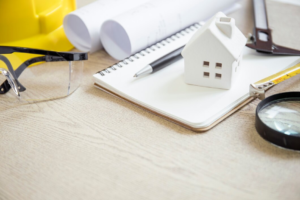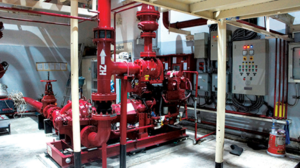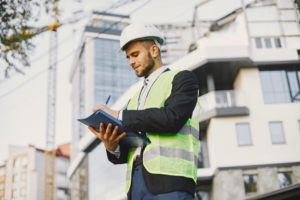Published 1/3/24
The Importance of Regular Property Inspections

A proactive approach to property maintenance extends beyond aesthetic considerations, encompassing strict adherence to regulatory codes and ensuring critical safety features. Compliance with building codes is not just a best practice; it is a legal obligation crucial for the safety of occupants and to avoid legal consequences. Essential safety features such as handrails and railings must be regularly inspected and maintained to prevent accidents, particularly in areas with stairs or elevated platforms. Proactively addressing potential hazards through routine building inspections is fundamental in identifying and mitigating issues before they escalate. Beyond safety, this approach offers long-term cost savings by preventing minor issues from turning into major problems, ultimately enhancing property value and attractiveness to occupants or potential buyers.
Key Safety Features: Inspection and Maintenance
Handrails and Railings
Handrails and railings are integral components of building safety, especially in multi-story structures. Compliance with code requirements regarding these features is essential to prevent accidents and injuries. Proactive maintenance should include regular inspections of handrails and railings to ensure they meet prescribed standards.
Handrail systems typically found along staircases and ramps, serve as a crucial support mechanism. They provide stability and support for individuals navigating through a building. Regular inspections should verify that handrails are securely anchored, at an appropriate height, and free from any defects that could compromise their strength.
Railings, which are commonly installed along balconies and elevated platforms, play a vital role in preventing falls. Property owners must ensure that railings are of sufficient height and strength to meet code requirements. Routine inspections should assess their stability and integrity, addressing any issues promptly to avoid potential hazards.
Fire Safety Systems

Fire safety systems are integral to swiftly detecting and extinguishing fires, safeguarding lives and property in emergencies. Consisting of alarms, sprinklers, and extinguishers, these systems demand regular scrutiny and upkeep. Testing fire alarms routinely guarantees their optimal performance, while maintenance of sprinkler systems is crucial to avert blockages or faults. Additionally, periodic checks and recharging of fire extinguishers are imperative. Adhering to fire safety codes stands as a fundamental requirement in this context.
Structural Integrity
The significance of a building’s structural integrity cannot be overstated, as it forms the bedrock of both its safety and long-term viability. Problems like cracks, settling, or compromised foundations have the potential to escalate into serious structural issues, ultimately resulting in collapses. To uphold the structural soundness, it is imperative to conduct routine inspections focused on identifying signs of damage. Vigilance should extend to monitoring for cracks in walls or foundations, detecting sagging roofs, and noting any irregularities in floor levels. Immediate attention to these structural concerns is essential to prevent their escalation and ensure the overall stability of the building. Regular inspection and timely maintenance are integral components in the proactive preservation of a structure’s integrity.
Electrical Systems
The significance of electrical systems in buildings cannot be overstated, given the substantial risk of fires and accidents associated with electrical issues. Conducting routine inspections on these systems plays a crucial role in pinpointing potential hazards, ultimately guaranteeing the safety of occupants. During inspections and maintenance checks, it is essential to be vigilant for indicators of faulty wiring, damaged outlets, or outdated electrical panels. Promptly addressing any exposed wires or overloaded circuits is vital to mitigating risks. Additionally, keeping electrical systems up to date with current safety standards through regular updates is fundamental in fostering a secure and hazard-free environment.
Emergency Exits
Emergency exits play a pivotal role in ensuring a prompt and secure evacuation in critical situations, such as fires or natural disasters. The accessibility and unobstructed functionality of these exits are paramount. To uphold their effectiveness, it is imperative to conduct routine inspections and maintenance. This involves regular testing of all emergency exits, confirming that exit doors open effortlessly without any hindrance. Additionally, proper signage should be installed to guide occupants effectively towards the exits and exit routes must be kept free of obstacles to guarantee a swift and unimpeded evacuation process.
Potential Hazards and Mitigation Strategies
Identifying and mitigating potential hazards is a fundamental aspect of proactive property maintenance. Hazards can range from structural deficiencies to environmental factors and addressing them promptly is crucial for preventing accidents and ensuring the well-being of occupants.
Mold and Mildew
Building code insulation requirements, including vapor barrier basement, are vital for addressing mold and mildew issues. By regulating temperature, managing humidity, and preventing moisture penetration, these measures go beyond regular inspections and ventilation. The combination of insulation and vapor barriers acts as a comprehensive solution to mitigate the risk of mold and mildew in buildings.
Slip and Trip Hazards
In addition to addressing uneven flooring, loose carpets, and wet surfaces through regular inspections, incorporating deck railings is a practical solution to enhance safety and prevent slip and trip hazards. Deck railings provide a physical barrier, reducing the risk of accidental falls and injuries. This preventive measure goes hand in hand with routine inspections to create a safer environment, mitigating potential liabilities associated with slip and trip hazards. The combination of thorough inspections, maintenance, and the installation of deck railings ensures a comprehensive approach to hazard prevention in various spaces.
Pest Infestations
Properties should be regularly inspected for signs of pest infestations. Implementing pest control measures and addressing any vulnerabilities in the building structure can help prevent damage and maintain a healthy living or working environment.
Compliance with Code Requirements

Adhering to building code requirements is essential for ensuring property safety and occupant well-being. For instance, building code insulation requirements, specifying standards for walls, roofs, and floors, significantly contribute to energy efficiency, maintaining consistent indoor temperatures, and improving durability. Compliance not only fosters a safer living environment but also leads to long-term cost savings through reduced energy consumption. Moreover, meeting these codes often qualifies builders for incentives and enhances property value. Additionally, adherence streamlines insurance processes, contributing to comprehensive risk management. Beyond individual properties, conformity to codes establishes community standards, creating a safer and more cohesive living environment for all residents.
Importance of Proactive Property Maintenance and Inspection

A proactive approach to property maintenance goes beyond addressing immediate issues; it involves a comprehensive strategy that adheres to regulatory guidelines and ensures the safety and longevity of the structure. Compliance with building codes, attention to critical safety features like handrails and railings, and the identification of potential hazards through regular inspections are all essential components of this approach. By investing time and resources into proactive maintenance, property owners can safeguard their assets, protect occupants, and contribute to the overall well-being of the community.
– Sam Willis
Author Bio:
Sam Willis is a freelance writer that loves sharing his knowledge and expertise in residential and commercial real estate, as well as engineering and construction. He lives in Atlanta, Georgia where he enjoys spending time with his wife and researching real estate trends in his free time. Sam’s work as a freelance writer can be found on Building Product Advisor, a construction industry resource site.
Recent Posts